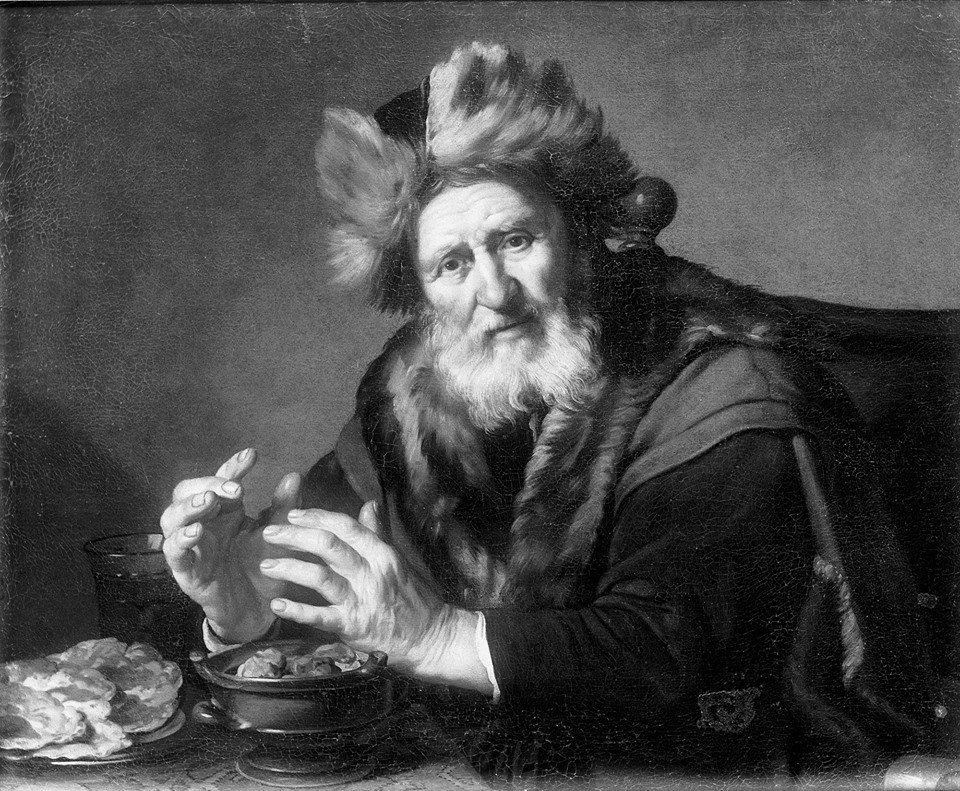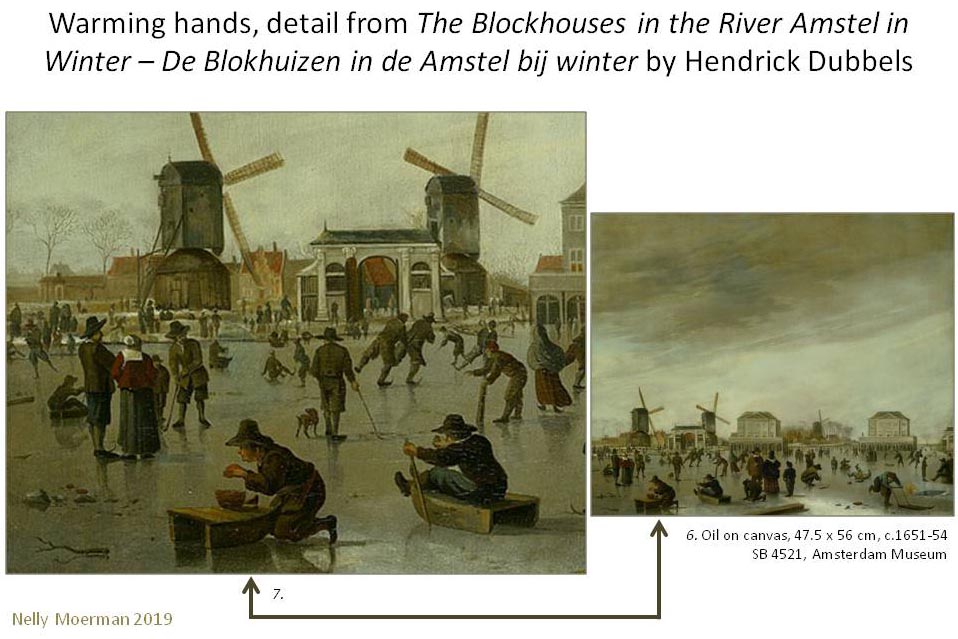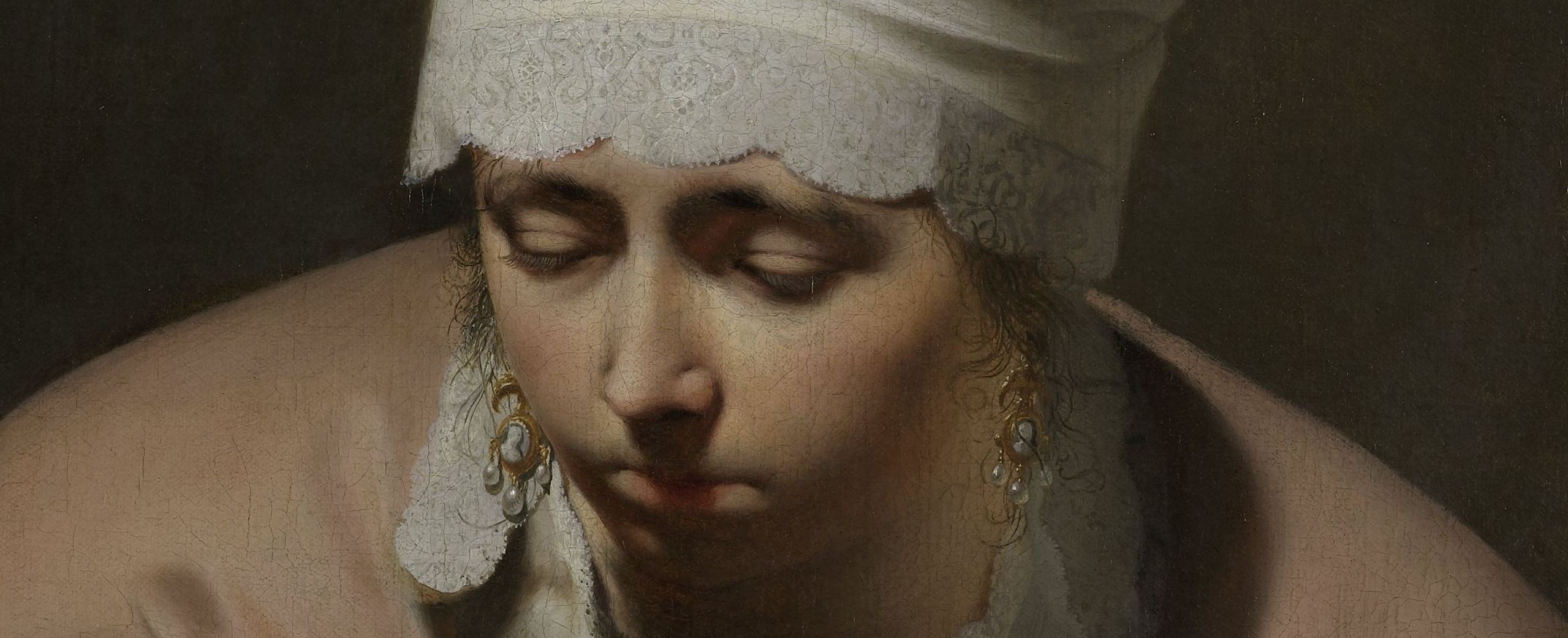The most beautiful painting in the Rijksmuseum
Introduction

A Young Woman Warming her Hands over a Brazier – Allegory of Winter, C.1650
Rijksmuseum SK-A-4878, Amsterdam
Nelly Moerman, author
Cis van Heertum, English translation
Have you ever considered which painting in the Rijksmuseum in Amsterdam you think is the most beautiful one? There are plenty of paintings to choose from. According to its own website, the Rijksmuseum’s collection contains 6,000 paintings on panel and canvas.
A skating lover’s choice
A skating lover of course prefers to choose from paintings that deal with winter, cold, ice and snow. Living in the Amsterdam area and being a frequent visitor of the Rijksmuseum, I for one have made up my mind. To me, the most beautiful painting in the Rijksmuseum is the painting by Caesar van Everdingen (1616/17-1678) formerly known as Allegory of Winter.(fig.1) What made me decide on this painting? I shall try to explain my choice.
Slightly leaning forward
The painting is an oil on canvas dating from c. 1650 and measuring 97 x 81 cm. A woman leaning forward slightly holds her hands under a cloth above a brazier with fiery coals. She is wearing a fur-trimmed cape of a strikingly beautiful pink colour. A white headdress lined with a broad band of lace covers her dark hair. Although the painting has not been awarded a place in the Rijksmuseum’s Gallery of Honour on the second floor, it is nevertheless to be found on the same floor, in a side corridor adjacent to the front hall. The advantage of this is that the painting can be viewed up close, making it possible to peruse even the smallest details.
Fascinating details and wonderful light reflections


There are plenty of details to admire. Just look at the small hairs near her ears emerging from under the white lace of the headdress. But also consider the gold embroidery along the lower edge of the magnificent cape, just above the fur lining. Or trace the reflection in the double row of pearls in the shadow of her neck. It makes you marvel how anybody can paint so meticulously and so beautifully. The artist also manages to achieve beautiful effects with light. The light comes from the left above, and the woman’s right earring catches the full light. (fig.2) A cameo with three suspended pearls is depicted against the white background of the lace trimming of her headdress. Although the other earring is in the shaded part of her face, it is still clearly visible. (fig.3) The painter makes ingenious use of a light reflection on the woman’s cheek caused by her cape. It is against this background that he paints the ear drop. As the woman is leaning forward slightly, the earring hangs free and the edge catches a little light.
Father and son Bloemaerts may have shown the way
 Allegorie van winter 1625-1630.jpg?1474034810161)
Allegory of Winter, 1625-30
Musée du Louvre, Paris

Old man as winter, 1631
Lost (source RKD)
There are some paintings from the time of Caesar van Everdingen that may have served as a model. A few pieces by the Utrecht painter Abraham Bloemaert (1566-1651) and his son Hendrick Bloemaert (1601-72) notably show a great similarity in pose. The first one (1625-1630) is in the Louvre in Paris. (fig.4)
The other one (1631) fell victim to the ravages of war in the city of Middelburg in the province of Zeeland in 1940. (fig.5) Both paintings depict a person warming his hands above a brazier. The gesture of warming hands is a regular feature of seventeenth-century paintings and must be regarded as a marker of winter conditions.
Winter is traditionally represented as an old man, and an old man warming his hands was readily understood by seventeenth-century viewers as an allegory of winter. We might say that the element of ‘warming hands’ is a clue or a ‘signal’. It transmits a message, and the meaning of this message is at least as important as the depiction itself.
Warming hands as a sign of winter
A fine example of this is offered in Hendrick Dubbels’ painting of The Blockhouses in the River Amstel in Winter - De Blokhuizen in de Amstel bij winter. (fig.6) The painting is part of the collection of the Amsterdam Museum and can be viewed online. It is a winter scene of the frozen river Amstel in Amsterdam with many people on the ice. Two so-called ‘blokhuizen’ (fortifications) have been built in the river to protect the city from invasions across water. On the left in the foreground we see a young man kneeling and warming his hands above a brazier placed on a wooden platform. (fig.7) The young man is a solitary figure and does not interact with anybody else. Warming your hands this way is not true to life. Nobody would kneel like this in the middle of the river Amstel to warm their hands while their knees would get cold through contact with the ice. Still, we understand what is signified: it is cold. The meaning of the element ‘warming hands’ is more important in this painting than a realistic depiction. Let us bear this in mind and return to the painting by Caesar van Everdingen.

The unknown lady
Who is this richly dressed mysterious lady with her gorgeous jewellery in her fur-trimmed cape of an exquisite colour? The painter has not provided a name and there are no documents that might shed any light on her identity. There is yet a second, similar painting now in England. This painting might be a copy. Others suggest it was a ‘modello’: a preparatory study made by a painter, after which he would then begin on the actual painting.
Upwelling tears and trembling lips

What might be the meaning of the depiction here? The woman is generally described as someone who is withdrawn into herself. If we look at her downcast eyes, however, it is not an introverted gaze. On the contrary! It is deep sorrow we are looking at. (fig.8) It seems as if she can hardly stop her tears from flowing. Her lips, on which the painter so beautifully managed to project the shadow of her nose, seem on the verge of trembling. And why the cloth over her hands? No woman I have discussed this detail with understands why you would risk holding a cloth over red hot coals. The suggestion by a few male authors that she is lifting her skirt so as to feel the warmth on her body is totally far-fetched. There must be another meaning. Might the meaning here be more important than the realism of the painting, too?
Visualisation of the painter’s own grief and sorrow?
Caesar van Everdingen belonged to a large family. He was a practising member of the Reformed Church, a community that values families with children. Van Everdingen married in 1648. Although he had many nephews and nieces, his own marriage remained childless. It appears from a will that was drawn up in 1655 that there was no longer any expectation of children being born from this union. He made the painting when he had been married a few years. Might it not be possible that the painter expressed his own emotions relating to his childless marriage? An artist is a classic example of someone who is capable of expressing emotions and feelings visually. This may be done consciously or unconsciously. Furthermore, when we consider a problem from a psychological angle we may talk of covering up. A profound sorrow can be covered. Might it be that by painting the green cloth, Caesar van Everdingen unconsciously signalled he wanted something covered up? These are of course the psychological views and the vocabulary of our own times, but coming to terms with loss was no different in the seventeenth century than it is now. It is also worth noting that the painter always kept both paintings (the original and the copy) in his own possession. After he died, his wife also held the two paintings with her until her own death in 1694. The two paintings must have been meaningful for both of them.
New title for the painting
Nowadays the painting has a different title: A Young Woman Warming her Hands over a Brazier. The title disregards her deeply sad eyes, while the painting as a matter of fact excels in its emotional expression. It is the very intensity of the emotion that appeals to me. On top of that there is the richness of colour and the refined manner of painting of an almost technical perfection. All this combined with the possible story behind it makes Caesar van Everdingen’s painting the most beautiful painting in the Rijksmuseum for me.
Further reading
The author has written a paper about the painting discussed above as part of her art history studies entitled Depressed Eyes, with an explanation of a grief and sorrow theory.
Sources
© Nelly Moerman 2016, 2019
This article is protected by copyright. Reproduction of the text, in whole or in part, is permitted only on an individual basis and under the conditions of acknowledgement of source and correct citation. In case of a financial interest or the pursuit of such an interest, copying is not allowed. In case of doubt, please contact the author, who can be reached through redactie@schaatshistorie.nl.
This article is a revised version of an article published in Kouwe Drukte (2016) no. 57, pp. 12-16 [ISSN 1572-4476]
Credits
Photos of Caesar van Everdingen’s painting courtesy of the Rijksmuseum, Amsterdam.
Photo of Hendrick Dubbels’ painting Blokhuizen in the Amstel courtesy of the Amsterdam Museum, Amsterdam.
Photo of Abraham Bloemaert’s painting provided by Musée du Louvre, Paris. Photo of Hendrick Bloemaert’s lost painting provided by RKD, The Hague.